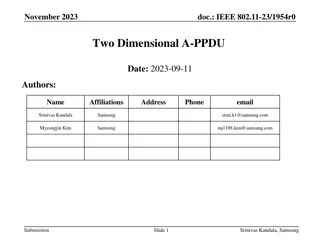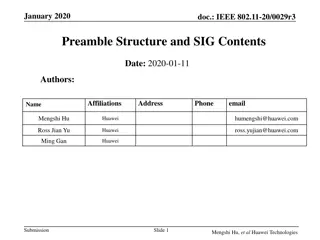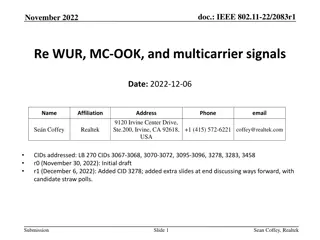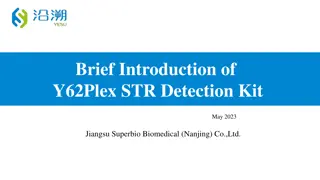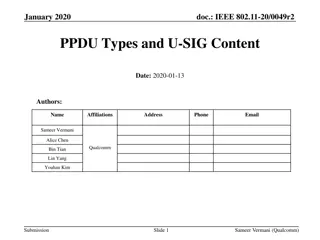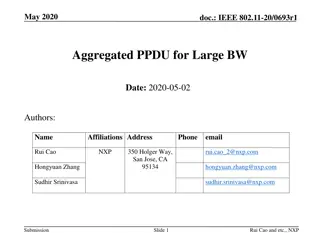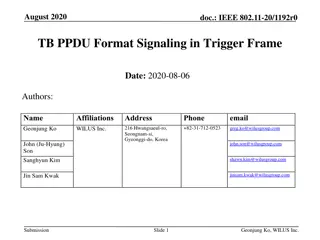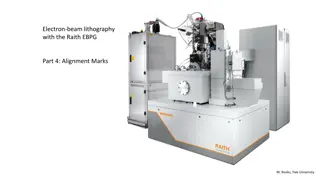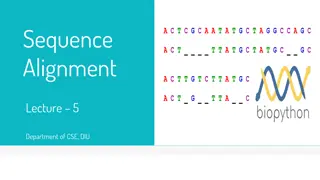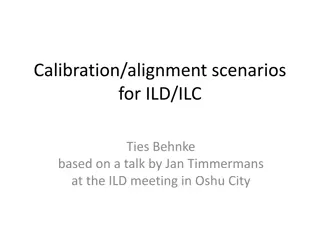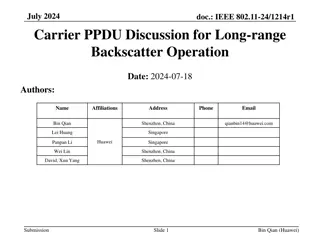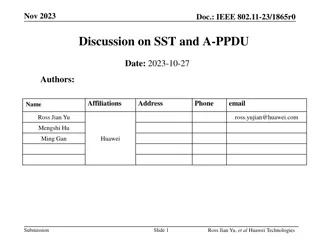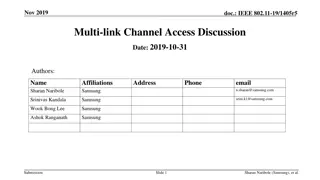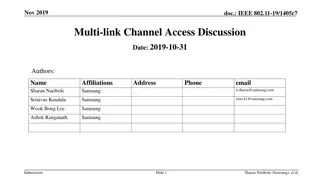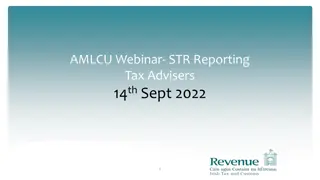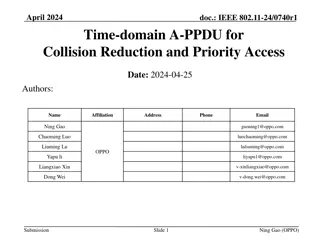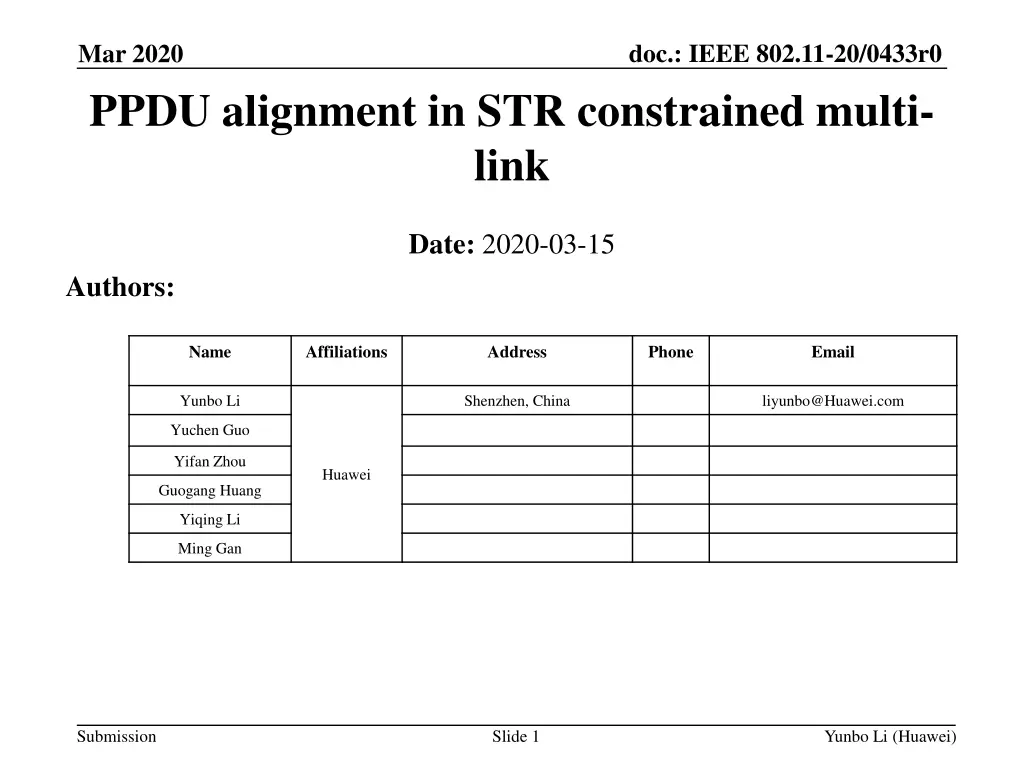
IEEE 802.11-20/0433r0: PPDU Alignment in Multi-Link Environment
This document discusses the alignment and time synchronization requirements for PPDU transmission in a constrained multi-link scenario within the IEEE 802.11-20 standard. It addresses the synchronization needs for Trigger/TB PPDU procedures and highlights the impact of cross-link power leakage on ED carrier sensing. The considerations for avoiding simultaneous transmission on different links are explored, emphasizing the importance of time synchronization to prevent interference.
Download Presentation

Please find below an Image/Link to download the presentation.
The content on the website is provided AS IS for your information and personal use only. It may not be sold, licensed, or shared on other websites without obtaining consent from the author. If you encounter any issues during the download, it is possible that the publisher has removed the file from their server.
You are allowed to download the files provided on this website for personal or commercial use, subject to the condition that they are used lawfully. All files are the property of their respective owners.
The content on the website is provided AS IS for your information and personal use only. It may not be sold, licensed, or shared on other websites without obtaining consent from the author.
E N D
Presentation Transcript
doc.: IEEE 802.11-20/0433r0 Mar 2020 PPDU alignment in STR constrained multi- link Date: 2020-03-15 Authors: Name Affiliations Address Phone Email Yunbo Li Shenzhen, China liyunbo@Huawei.com Yuchen Guo Yifan Zhou Huawei Guogang Huang Yiqing Li Ming Gan Submission Slide 1 Yunbo Li (Huawei)
doc.: IEEE 802.11-20/0433r0 Mar 2020 Motivation When a MLD has STR constrain on two links, the PPDUs transmitted on the two links need to do time synchronization to avoid simultaneous transmit and receive on different links; The synchronization in Data/BA procedure is discussed in presentation 19/1305, but the sync requirements of Trigger/TB PPDU procedure hasn t been discussed; ED carrier sensing is needed before TB PPDU transmission, it is quite different from BA response which doesn t require ED carrier sensing; The sync requirements in Trigger/TB PPDU procedure are discussed in this document. Submission Slide 2 Yunbo Li (Huawei)
doc.: IEEE 802.11-20/0433r0 Mar 2020 Example The cross link power leakage during SIFS doesn t affect the BA response, but will blocks the ED carrier sensing before TB PPDU; cross link leakage will be ignored SIFS BA A-MPDU1 Link 1 BA2 A-MPDU2 Link 2 SIFS cross link leakage will blocks the ED CS for TB PPDU SIFS TB PPDU A-MPDU1 with Trigger frame Link 1 BA2 A-MPDU2 Link 2 SIFS Submission Slide 3 Yunbo Li (Huawei)
doc.: IEEE 802.11-20/0433r0 Mar 2020 Recap: SIFS SIFS time = D1 + M1 + Rx/Tx; D1 and M1 periods are used for PHY and MAC process, which can do ED carrier sensing in parallel; ED carrier sensing can not be performed during Rx/Tx period. Submission Slide 4 Yunbo Li (Huawei)
doc.: IEEE 802.11-20/0433r0 Mar 2020 Sync for TB PPDU in One link The starting time of BA2 can not be earlier than Rx/Tx time before TB PPDU, otherwise ED CS will be blocked in link 1; In other words, the ending time of PPDU2 can not be earlier than Rx/Tx time before ending time of PPDU1 Similar as Data/BA case, the ending time of PPDU2 can not be later than the ending time of PPDU1 plus SIFS, otherwise the reception of PPDU2 will be blocked by power leakage of TB PPDU in link 1. SIFS TB PPDU PPDU1 carries Trigger frame Link 1 Rx/Tx D1 M1 Link 2 SIFS BA2 PPDU2 SIFS BA2 PPDU2 Link 2 Earliest ending time Latest ending time Submission Slide 5 Yunbo Li (Huawei)
doc.: IEEE 802.11-20/0433r0 Mar 2020 Sync for TB PPDU in One link A margin of 10% aSlotTime considers the SIFS accuracy of the IEEE 802.11-2016 spec; Considering the margin of 10% aSlotTime, the rules will be the ending time of PPDU2 can not be earlier than (Rx/Tx- 10% aSlotTime) before ending time of PPDU1; The ending time of PPDU2 can not be later than the ending time of PPDU1 plus (SIFS- 10% aSlotTime). SIFS TB PPDU PPDU1 carries Trigger frame Link 1 Rx/Tx D1 M1 Link 2 SIFS BA2 PPDU2 SIFS BA2 PPDU2 Link 2 Earliest ending time Latest ending time Submission Slide 6 Yunbo Li (Huawei)
doc.: IEEE 802.11-20/0433r0 Mar 2020 Sync for TB PPDUs in Two Links When both links are expected to receive TB PPDUs The difference between the ending times of PPDU1 and PPDU2 shall be less than or equal to Rx/Tx Considering the margin of 10% aSlotTime, the rule will be The difference between the ending times of PPDU1 and PPDU2 shall be less than or equal to (Rx/Tx- 10% aSlotTime) ; SIFS TB PPDU1 PPDU1 carries Trigger frame Link 1 Rx/Tx D1 M1 Link 2 SIFS TB PPDU2 PPDU2 carries Trigger frame Rx/Tx D1 M1 SIFS TB PPDU2 PPDU2 carries Trigger frame Link 2 Rx/Tx D1 M1 Earliest ending time Latest ending time Submission Slide 7 Yunbo Li (Huawei)
doc.: IEEE 802.11-20/0433r0 Mar 2020 Rx/Tx time The length of Rx/Tx duration is implementation related, how to determine it in the equations? Opt 1: common Rx/Tx A fixed value for Rx/Tx (e.g. called Rx/Tx0) is used for all STAs, it could be defined in standard; Opt 2: individual Rx/Tx Each STA report its own Rx/Tx value to AP, e.g. report during association procedure. Opt 1 is preferred. Submission Slide 8 Yunbo Li (Huawei)
doc.: IEEE 802.11-20/0433r0 Mar 2020 Summary 1 When a MLD1 transmit PPDU1 and PPDU2 in link 1 and link 2 respectively to a MLD2 which is STR constrained, if PPDU1 and PPDU2 has time domain overlapping, and PPDU1 carries a Trigger frame, then the ending time of PPDU2 can not be earlier than (Rx/Tx- 10% aSlotTime) before ending time of PPDU1; The ending time of PPDU2 can not be later than the ending time of PPDU1 plus (SIFS- 10% aSlotTime). When a MLD1 transmit PPDU1 and PPDU2 in link 1 and link 2 respectively to a MLD2 which is STR constrained, if PPDU1 and PPDU2 has time domain overlapping, and both PPDU1 and PPDU2 carry Trigger frames, then The difference between the ending times of PPDU1 and PPDU2 shall be less than or equal to (Rx/Tx- 10% aSlotTime) ; Submission Slide 9 Yunbo Li (Huawei)
doc.: IEEE 802.11-20/0433r0 Mar 2020 Summary 2 If a fixed value Rx/Tx0 is used, 10% aSlotTime can also count into Rx/Tx0. Then the synchronization requirements will be: When a MLD1 transmit PPDU1 and PPDU2 in link 1 and link 2 respectively to a MLD2 which is STR constrained, if PPDU1 and PPDU2 has time domain overlapping, and PPDU1 carries a Trigger frame, then the ending time of PPDU2 can not be earlier than Rx/Tx0 before ending time of PPDU1; The ending time of PPDU2 can not be later than the ending time of PPDU1 plus (SIFS- 10% aSlotTime). When a MLD1 transmit PPDU1 and PPDU2 in link 1 and link 2 respectively to a MLD2 which is STR constrained, if PPDU1 and PPDU2 has time domain overlapping, and both PPDU1 and PPDU2 carry Trigger frames, then The difference between the ending times of PPDU1 and PPDU2 shall be less than or equal to Rx/Tx0; Submission Slide 10 Yunbo Li (Huawei)
doc.: IEEE 802.11-20/0433r0 Mar 2020 Straw Poll 1 Do you support to introduce synchronization rules for TB PPDU transmission in synchronous multi-link? Yes No Abstain Submission Slide 11 Yunbo Li (Huawei)
doc.: IEEE 802.11-20/0433r0 Mar 2020 Straw Poll 2 Do you support below synchronization requirement? When a MLD1 transmit PPDU1 and PPDU2 in link 1 and link 2 respectively to a MLD2 which is STR constrained, if PPDU1 and PPDU2 has time domain overlapping, and PPDU1 carries a Trigger frame, then the ending time of PPDU2 can not be earlier than T1 time before ending time of PPDU1; The ending time of PPDU2 can not be later than the ending time of PPDU1 plus (SIFS- 10% aSlotTime). Note 1: T1 equals to (Rx/Tx- 10% aSlotTime) or Rx/Tx0 Note 2: How to determine T1 is TBD Yes No Abstain Submission Slide 12 Yunbo Li (Huawei)
doc.: IEEE 802.11-20/0433r0 Mar 2020 Straw Poll 3 Do you support below synchronization requirement? When a MLD1 transmit PPDU1 and PPDU2 in link 1 and link 2 respectively to a MLD2 which is STR constrained, if PPDU1 and PPDU2 has time domain overlapping, and both PPDU1 and PPDU2 carry Trigger frames, then The difference between the ending times of PPDU1 and PPDU2 shall be less than or equal to T2; Note 1: T2 equals to (Rx/Tx- 10% aSlotTime) or Rx/Tx0 Note 2: How to determine T2 is TBD Yes No Abstain Submission Slide 13 Yunbo Li (Huawei)
doc.: IEEE 802.11-20/0433r0 Mar 2020 Straw Poll 4 Which option do you prefer to determine the value of Rx/Tx in synchronization requirements for STR constrained multi-link? Opt 1: common Rx/Tx Define a fixed value for Rx/Tx (e.g. called Rx/Tx0) for all STAs in the standard; Opt 2: individual Rx/Tx Each STA reports its Rx/Tx value to AP, e.g. report during association procedure. Other methods. Submission Slide 14 Yunbo Li (Huawei)

